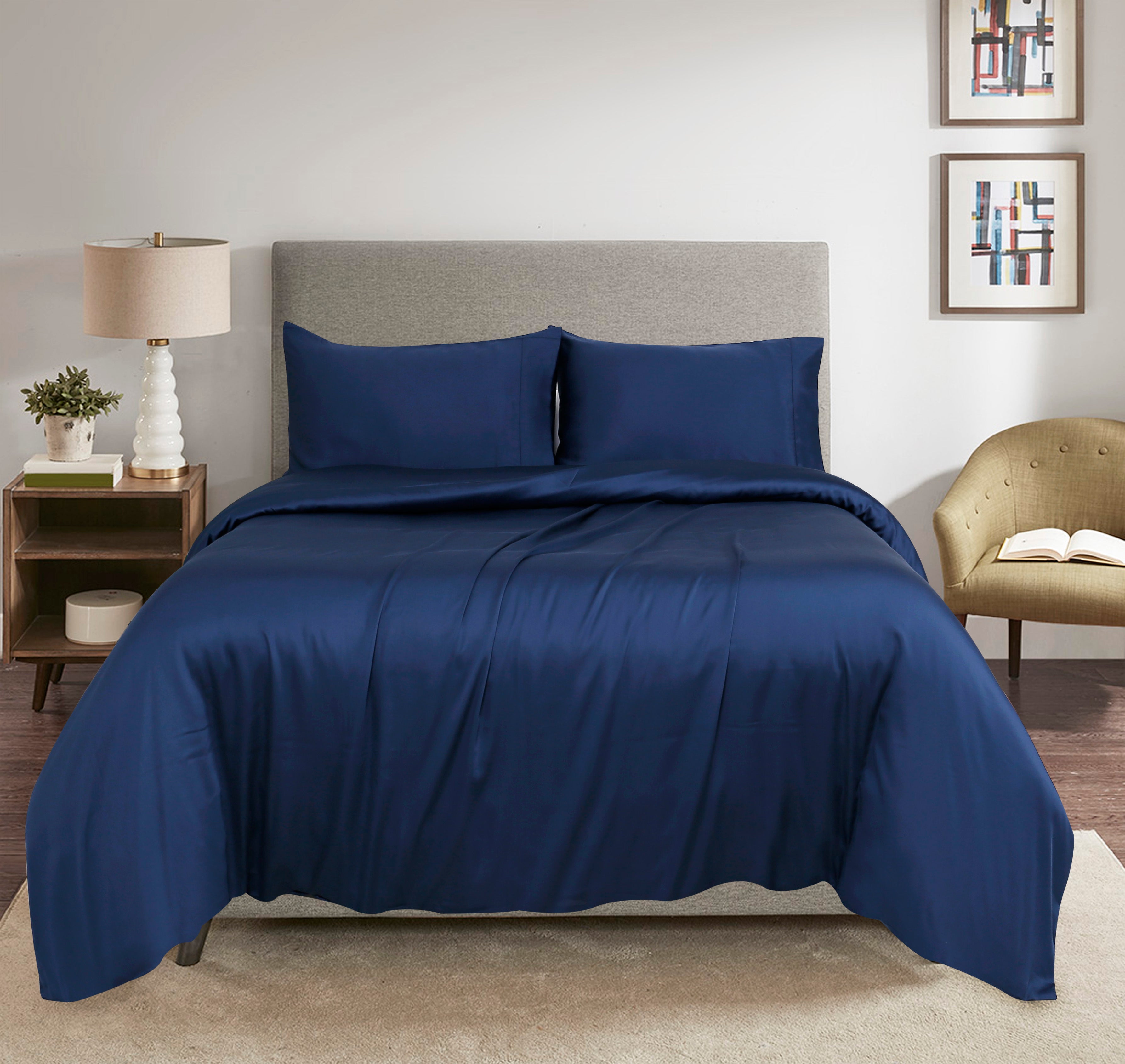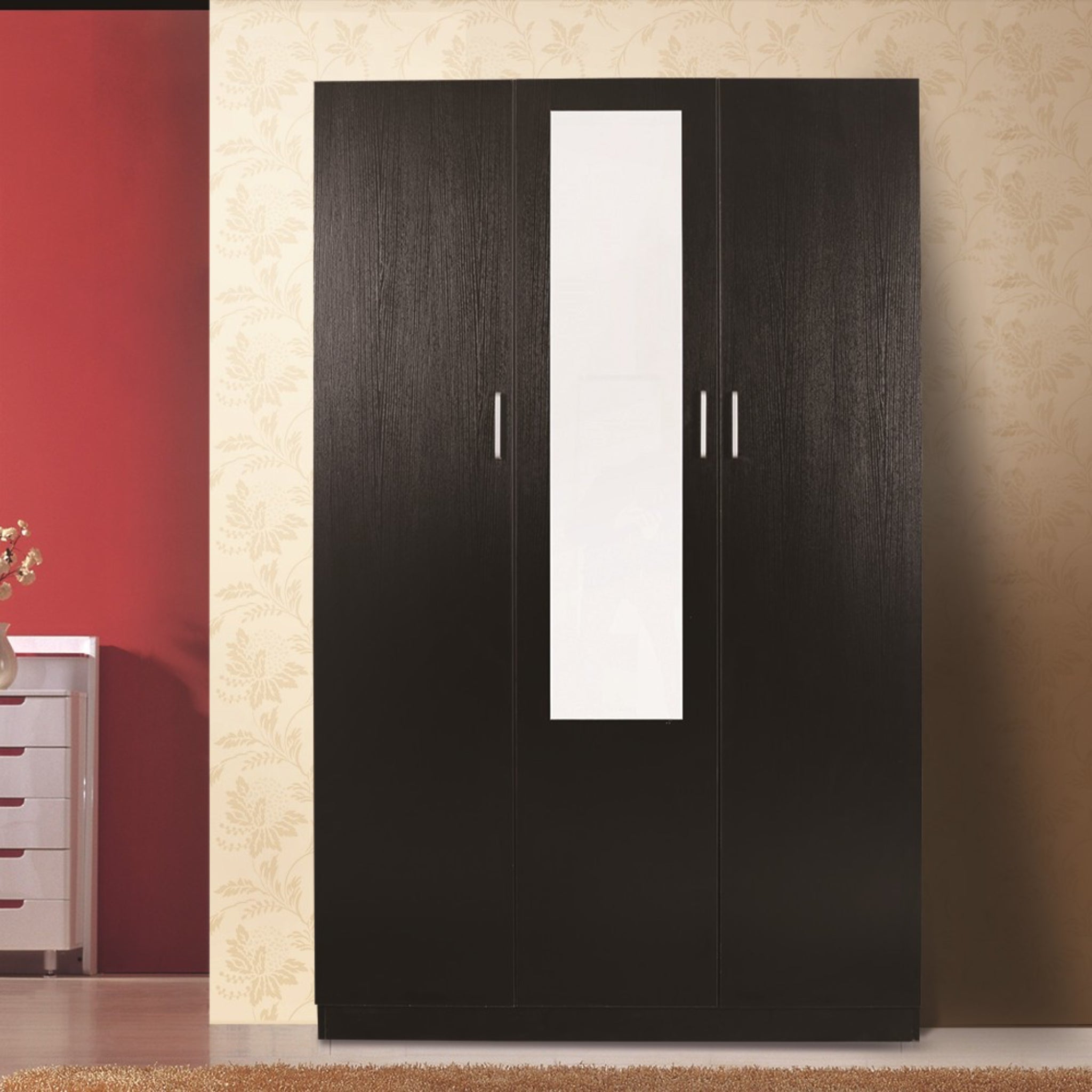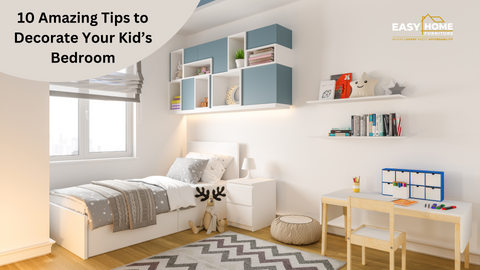Taking care of your leather furniture isn’t a chore; it’s a simple routine that protects your investment and keeps it looking its best. The secret is consistency. A little bit of regular attention—we’re talking weekly dusting, a gentle clean once a month, and conditioning every few months—is all it takes. This simple rhythm stops dirt from building up and keeps the leather soft and supple, ensuring it looks fantastic for years, not just seasons.
Your Essential Leather Furniture Care Checklist
When you bring a beautiful leather sofa or armchair into your home, you're making a long-term commitment. Unlike a lot of other fabrics, leather gets better with age, developing a unique patina and character. But that only happens with the right care. If you let it go, you risk the leather drying out, cracking, and suffering damage that you just can't undo. Knowing how to properly look after your leather furniture is about more than just mopping up the odd spill; it’s about a proactive maintenance plan that preserves its beauty and value.
First things first, you need to know what kind of leather you have. Different types need different levels of care. High-quality furniture is usually made from top-grain or full-grain leather, which are incredibly durable. Bonded leather, on the other hand, is a more budget-friendly choice but requires a different approach to cleaning and conditioning.
As you can see, the premium options are what most people have in their homes.
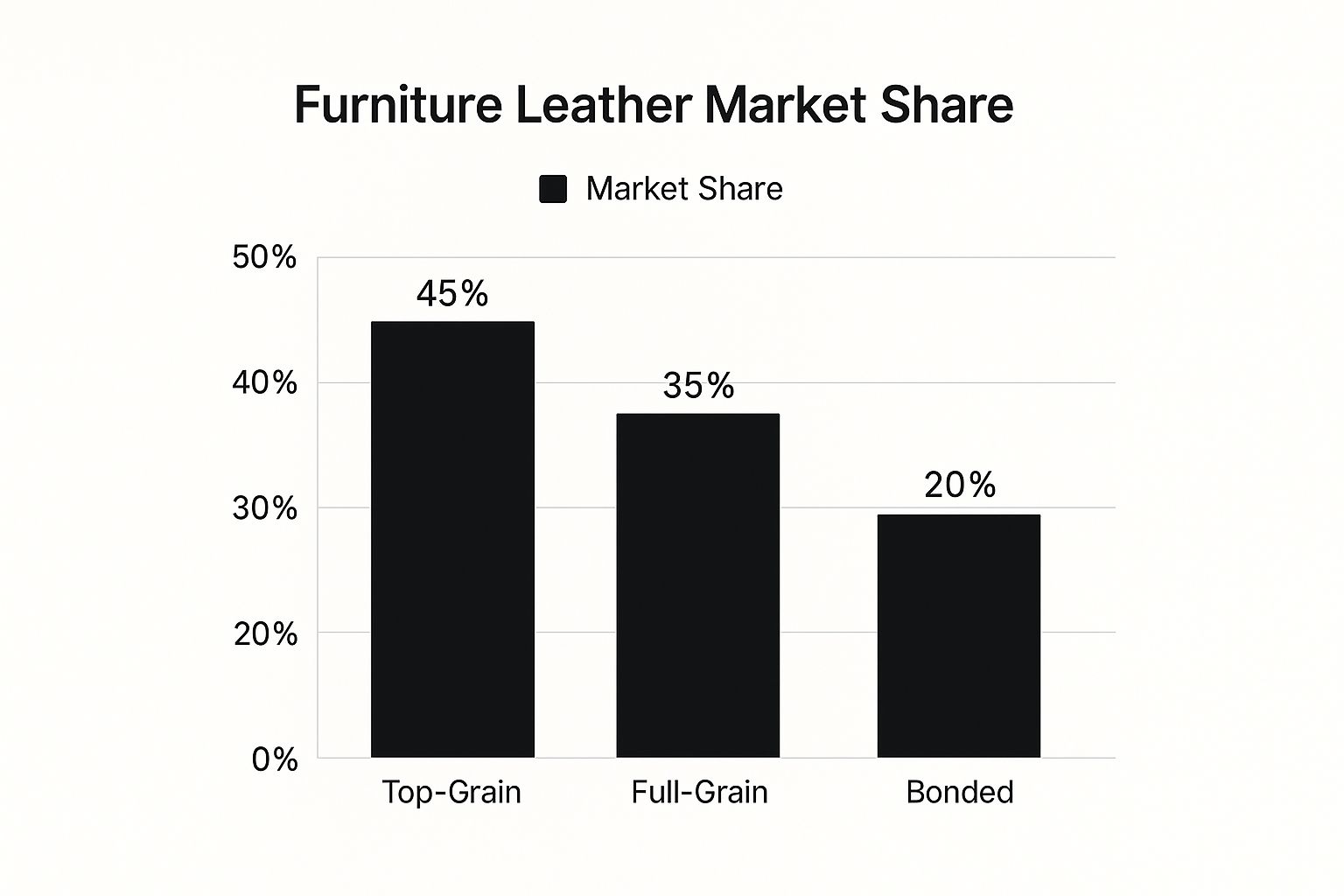
With top-grain and full-grain leather making up the lion's share of the market (45% and 35% respectively), it's clear why understanding proper care for these high-quality materials is a must for most furniture owners.
Building Your Care Routine
The easiest way to stay on top of things is to create a simple care schedule. This isn’t about blocking out your entire Saturday. It's about weaving a few small, effective tasks into your normal cleaning routine. A bit of regular attention makes a huge difference and helps you avoid the common problems that can ruin leather furniture.
Here's a breakdown of what that looks like:
- Weekly: Give it a quick dust with a soft, dry microfibre cloth. This simple wipe-down gets rid of the dust and grit that can cause tiny, abrasive scratches over time.
- Monthly: Do a more thorough wipe-down using a slightly damp cloth. I always recommend using distilled water, as it won't leave behind mineral spots. The key is to never soak the leather—just a light touch is enough to lift away oils and light grime.
- Every 3-6 Months: This is the big one—apply a good quality leather conditioner. This step is absolutely crucial for preventing the leather from drying out and cracking, especially if your home has dry air or your furniture gets a lot of sun.
A well-cared-for leather sofa is more than just a piece of furniture; it becomes the heart of the room, telling a story. Think of conditioning like moisturising your skin—it keeps the material flexible, keeps the colour rich, and makes it tough enough to handle everyday life.
Sticking to a basic schedule like this sets the foundation for a piece of furniture that will age beautifully. It's all about being proactive. Of course, that proactive mindset starts with the piece you buy. If you’re still shopping around, getting tips on how to choose the perfect furniture for your living room can help you find something that fits your home and your lifestyle perfectly. Once you have it, this checklist will be your go-to guide for keeping it in amazing condition.
To make it even easier, here's a quick summary you can refer to throughout the year.
At-a-Glance Leather Care Schedule
| Frequency | Task | Why It Matters |
|---|---|---|
| Weekly | Dust with a soft, dry microfibre cloth. | Removes abrasive surface grit that can scratch the finish over time. |
| Monthly | Wipe with a slightly damp cloth (distilled water). | Cleans away body oils, light spills, and accumulated grime. |
| Every 3-6 Months | Apply a quality leather conditioner. | Replenishes natural oils, preventing dryness, cracking, and fading. |
| As Needed | Blot spills immediately with a clean, dry cloth. | Prevents liquids from soaking in and causing permanent stains. |
Following this simple schedule takes the guesswork out of leather care and turns it into a simple, rewarding habit.
First, Know Your Leather Type
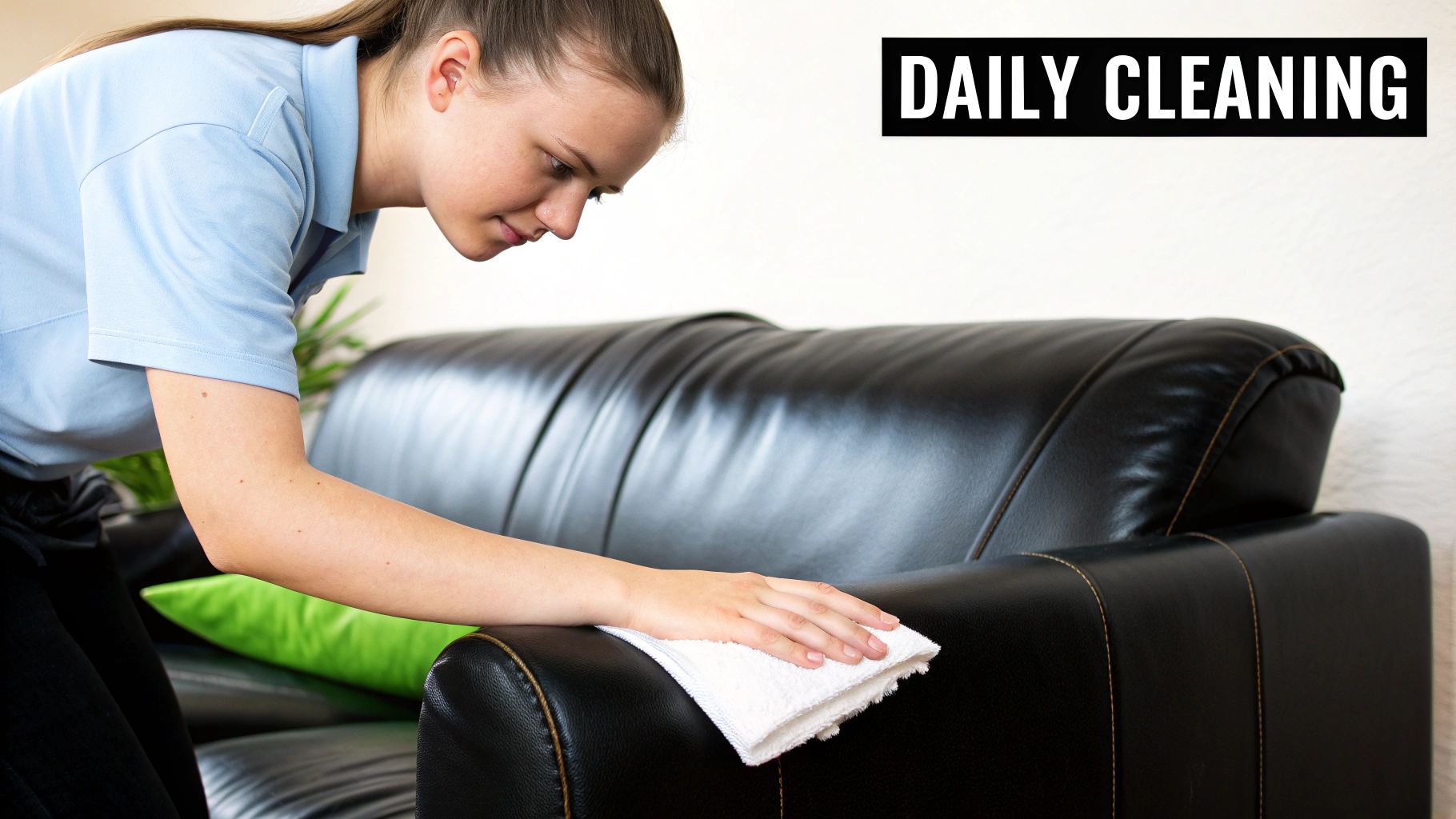
Before you even think about reaching for a cleaner or conditioner, you absolutely have to know what kind of leather you’re dealing with. It’s the single most important part of the process. I can't stress this enough: using the wrong product can turn a small cleaning job into a disaster, leaving you with a permanent stain or a dried-out, cracked finish.
Think of it like skincare. You wouldn’t use a harsh, abrasive scrub on delicate skin, right? The same logic applies to your lounge suite. Full-grain leather, for instance, is the real deal—it's the top layer of the hide with all its natural markings and character. It’s tough as nails. Then you have top-grain, which is a little more refined because the surface has been sanded down to create a more uniform look. It's still incredibly strong, just a bit different.
What’s the Finish? That’s the Real Question
The type of grain is one thing, but the finish is what truly dictates how you'll clean your furniture. Most leather sofas fall into one of three main categories.
- Aniline Leather: This is as natural as it gets. It’s dyed with soluble dyes but has no protective topcoat. The result is a stunningly soft, breathable leather, but it’s also a magnet for spills and stains. It will absorb just about anything, so it needs a gentle touch.
- Semi-Aniline Leather: This is the happy medium. It has a light protective coating, which gives you a bit more time to wipe up a spill before it sinks in. You still get that lovely soft feel and much of the leather's natural charm, but with added durability for everyday life.
- Pigmented (or Protected) Leather: This is the workhorse of the leather world and by far the most common for family furniture. A polymer coating mixed with pigments sits on the surface, making it super resistant to stains, fading, and scratches. It’s built for kids, pets, and life’s little messes.
Here's a quick expert tip: The water test is your best friend for identifying your leather. Find a hidden spot, maybe on the frame behind a cushion, and put a single drop of water on it.
- Does it soak in almost instantly? That’s aniline.
- Does it bead up for a minute before slowly disappearing? You've got semi-aniline.
- Does the water droplet just sit there on the surface, not going anywhere? That’s pigmented leather.
Taking a moment to understand this is the foundation of proper leather care. It’s what stops you from making a costly mistake and helps you choose the right products off the shelf. While leather's durability is a huge drawcard, knowing how it stacks up against other materials is also key. If you're still weighing your options, our guide on choosing between leather, fabric, or velvet for your sofa offers some great perspective.
Once you know your leather, you’re in control. You can confidently buy the right cleaners and conditioners, knowing you're preserving your investment and helping it develop that beautiful, rich patina that only comes with age and proper care.
Your Go-To Cleaning and Conditioning Routine
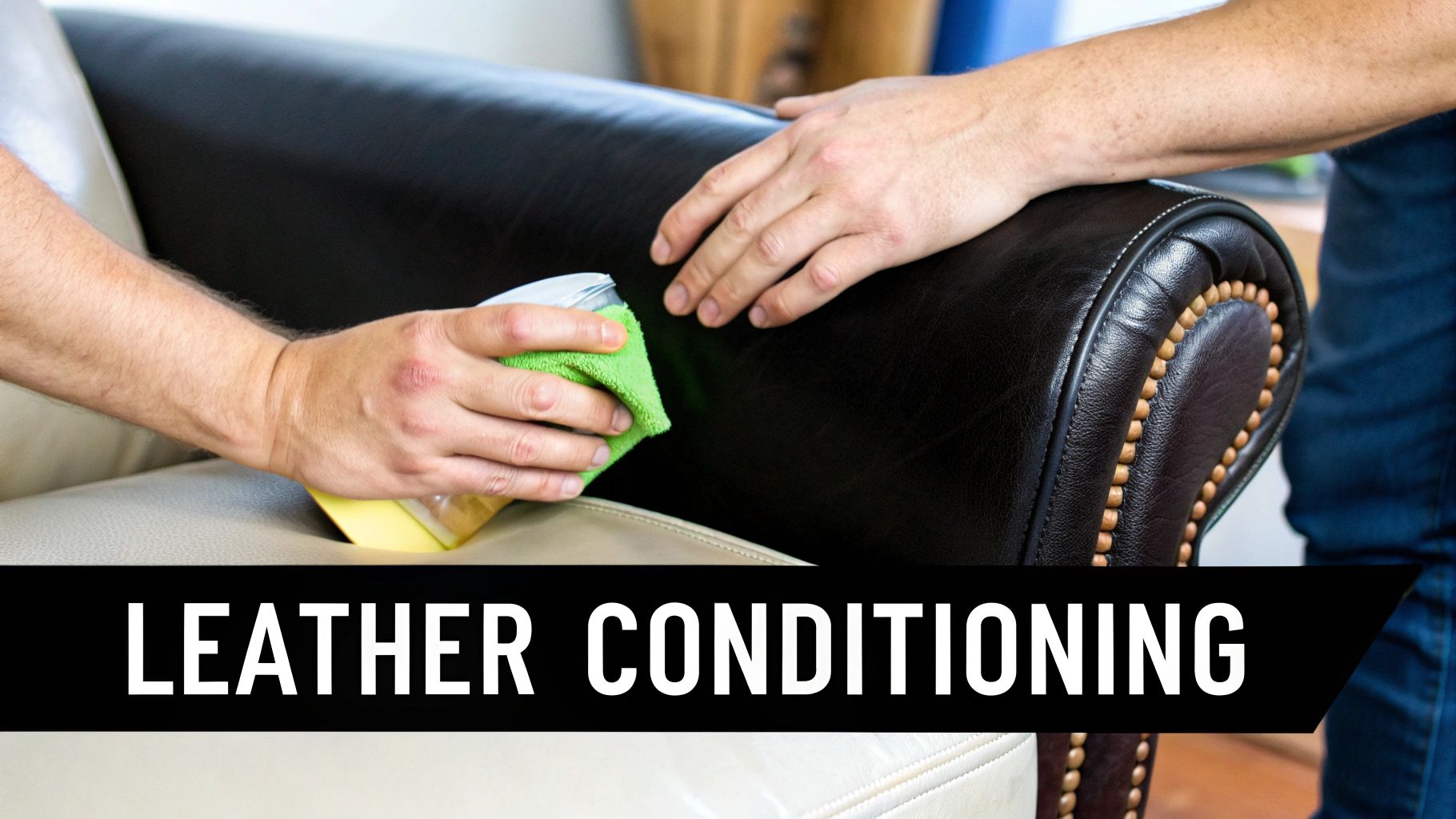
The real secret to keeping your leather lounge looking incredible for years isn't some magic product—it's consistency. If you get into a simple, regular rhythm of care, you’ll prevent most common problems before they even start. This doesn't mean you need to spend hours on upkeep; it's all about weaving a few small, effective steps into your normal cleaning schedule.
Your foundation for leather care should be a quick weekly dust-down. Just take a dry, soft microfibre cloth and give all the surfaces a gentle wipe. This seemingly minor task is a big deal; it lifts away the abrasive dust, dander, and other tiny particles that can create micro-scratches on the leather's surface over time. Think of it as the easiest preventative maintenance you can do.
Once you’ve got that down, a slightly deeper clean once a month will keep everything looking fresh.
The Gentle Monthly Clean
For this monthly refresh, you'll need a cloth that's just barely damp. Over-saturating the leather is a huge no-no, so be careful here. Simply dampen a clean microfibre cloth with a bit of pH-neutral soap mixed into distilled water, and then wring it out until it feels almost dry to the touch.
Wipe down the entire piece, giving a little extra attention to the spots that get the most contact, like the armrests and headrests where body oils tend to build up. Work in manageable sections, and always follow up immediately with a separate dry, soft cloth to buff the area. This two-part method lifts the grime away without leaving any moisture behind that could cause damage.
While this works wonders for leather, other materials need a different approach. If you have other furniture, our guide on how to clean fabric upholstery has you covered.
The biggest mistake I see people make is reaching for an all-purpose cleaner or those convenient household wipes. They often contain alcohol and harsh chemicals that will strip the protective finish right off your leather, leading to dryness, discolouration, and eventually, cracking.
The Art of Conditioning
Conditioning is what keeps leather soft, supple, and able to withstand daily life. It essentially replenishes the natural oils within the hide, stopping it from drying out. For most homes, applying a quality conditioner every 3 to 6 months is the sweet spot.
However, we can’t forget Australia's climate. The intense UV exposure here can be particularly tough on leather furniture. That's why having a structured routine is so vital for its longevity. A great rule of thumb is weekly dusting, a monthly damp wipe, conditioning every 3 to 6 months, and booking a professional clean every 12 to 18 months for a deep restoration.
So, how do you know when it's time to condition?
- Feel the Leather: If it starts to feel a bit stiff or not as pliable as it used to, it’s asking for a drink.
- Look at the Finish: A dull or lacklustre appearance is another dead giveaway that the leather is thirsty.
- Consider Your Environment: If you're in a very dry part of the country or have the heating on a lot during winter, you’ll probably need to condition closer to every 3 months.
When you're ready, dab a small amount of a good leather conditioner onto a clean cloth. Always test it on a hidden spot first—under a cushion is perfect. Once you’re happy, apply it to the furniture in a thin, even layer using a gentle circular motion. Let it soak in for about an hour, then come back with a new, clean cloth and buff off any excess. You’ll be left with a beautiful, healthy sheen, not a greasy mess.
How to Handle Spills, Stains, and Scratches
Life happens on a leather sofa. Whether it’s a morning coffee, a glass of wine, or an enthusiastic pet, spills and scratches are pretty much inevitable. The secret isn't trying to create a museum piece but knowing how to respond quickly and effectively when life gets a little messy. The right reaction can make the difference between a minor cleanup and a lasting mark.
The first rule of any spill is simple: blot immediately, never rub. Grabbing a cloth and scrubbing might feel like the right thing to do, but it just pushes the liquid deeper into the leather's pores and spreads the stain. It’s a guaranteed way to make a small problem much bigger. Always reach for a clean, dry microfibre cloth and gently press it onto the spill, letting it soak up the liquid.
Tackling Common Spills and Stains
After you’ve blotted up the excess, what you do next really depends on the type of leather you have and what was spilt. With protected leather, a simple water spot will often disappear on its own if you just let it air dry.
For anything more serious, a gentle hand is your best friend.
- Grease and Oil Stains: That dropped chip or buttery popcorn kernel can leave a nasty mark. The trick is to act fast. Sprinkle a bit of cornflour or talcum powder directly onto the spot. Don't rub it in; just let it sit there for a few hours. The powder will draw the oil out of the leather. Afterwards, you can just gently brush it away.
- Ink Marks: Ink is the enemy, and honestly, it’s a tricky one. If you have protected leather and catch it straight away, you might have some luck dabbing the mark with a cotton swab dipped in isopropyl alcohol. But please, test this on a hidden spot first—like under a cushion—because it can strip the colour from more delicate aniline leathers.
- Dye Transfer: Ever stood up to find your new dark jeans have left a blue shadow on your cream-coloured lounge? It's a classic problem. This usually calls for a specialised leather cleaner designed to lift the transferred dye without affecting the sofa’s original colour.
Don’t forget that everyday life and where you live impacts your leather. For example, dust on light-coloured leather, a favourite in many Australian homes, can cause tiny scratches over time if not wiped away weekly. In a busy home with kids or pets, knowing to blot spills instantly is non-negotiable.
Dealing with Scuffs and Minor Scratches
Let’s be honest, minor scuffs and scratches can actually add to the unique character of leather furniture. But if a particular mark is driving you mad, there are ways to make it less noticeable.
Sometimes, for a very light surface scratch, all you need is a bit of warmth and friction. Try rubbing the spot firmly with your fingertips. The heat from the friction can warm up the natural oils already in the leather, which often helps the scratch fade right back into the surrounding finish.
For scratches that go a little deeper, a good quality leather conditioner or a colour-matched repair balm can be a lifesaver. Put a small amount on a soft cloth and work it into the scratch with a gentle, circular motion, then buff the entire area. This rehydrates the fibres and helps the blemish blend in. It's worth remembering that the sofa's colour can play a big role in how visible these marks are; our guide on how to choose a perfect sofa colour has some great tips on that front.
Long-Term Strategies to Protect Your Investment
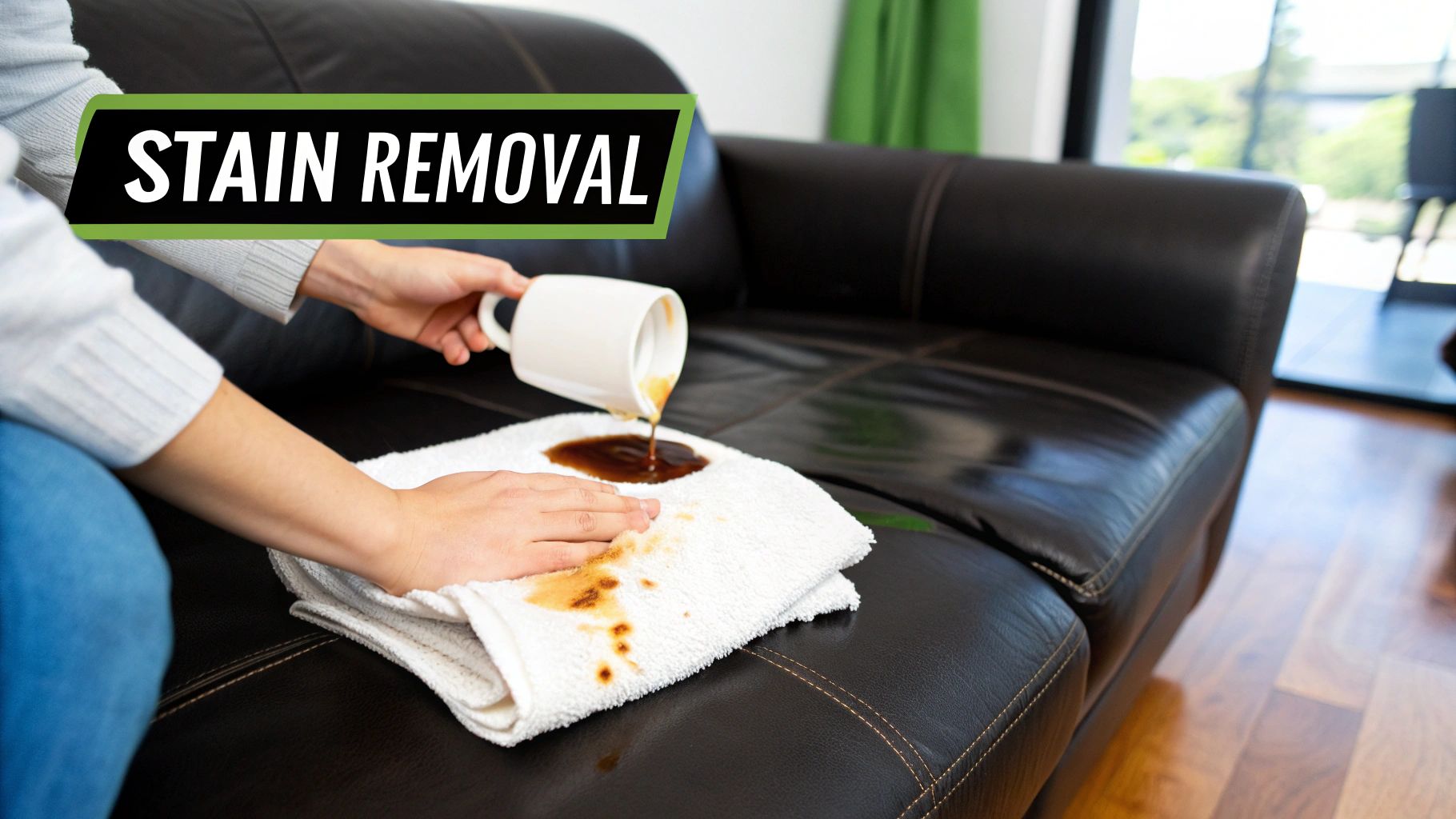
True furniture care goes far beyond just wiping up the occasional spill; it's about playing the long game. The real secret to a leather sofa that becomes a cherished heirloom, rather than just looking good for a year, is proactive protection. And it all starts with a simple, cost-free strategy: thoughtful placement.
Sunlight and heat are the arch-enemies of supple leather. Just like our own skin, constant exposure to direct UV rays and the dry air from heaters or fireplaces will sap moisture from the hide. This inevitably leads to the two things every leather owner dreads: irreversible colour fading and brittle cracking.
Before you decide on the final spot for your new lounge, take a day to watch how the sun moves through the room. If the only perfect spot happens to be right by a sunny window, it's not a deal-breaker. Simply think about using blinds, curtains, or even UV-filtering film to block the harshest rays. A little prevention here goes a very long way.
The Value of Professional Care
While your own cleaning and conditioning routine is absolutely essential, there are times when it pays to call in the experts. Think of it as a deep-tissue massage for your furniture; a professional has the right equipment and specialised products to deeply cleanse and rejuvenate the leather in a way that home methods just can't match.
As a rule of thumb, scheduling a professional deep clean and conditioning every 12 to 18 months is a brilliant investment in your furniture's future. They can properly remove the ingrained dirt and body oils that build up in the pores over time, then apply high-grade conditioners that restore flexibility and bolster the leather's protective finish.
Calling a professional isn't admitting defeat; it's a savvy move to extend the life of your furniture. They can often spot and address minor issues—like the very beginning of colour loss or dryness in high-wear areas—before they turn into major headaches.
This kind of proactive professional care is a huge factor in the longevity of quality furniture. With diligent upkeep, premium Australian leather sofas can easily last 15 to 20 years or more.
Living Harmoniously With Pets
Sharing your home with a furry family member doesn't mean you have to sacrifice your dream of having a beautiful leather lounge. It just requires a few smart adjustments. The main culprits you’re up against are sharp claws and the natural oils in their fur.
Here are a few practical tips I always give to pet owners:
- Keep Nails Trimmed: This is your first and best line of defence. Regularly trimming your pet's nails is the single most effective way to prevent deep, accidental scratches.
- Provide Tempting Alternatives: Make a cosy pet bed or a new scratching post seem far more appealing than the sofa. A little strategic placement near your lounge can work wonders.
- Use Stylish Throws: A well-placed, attractive throw blanket on their favourite snoozing spot is a win-win. It adds a lovely decorative touch while creating a crucial barrier between their claws and coat oils, which can discolour leather over time.
Don't forget, the colour of your sofa can also help camouflage the minor marks of a well-loved piece of furniture. You can explore some great ideas in our guide on how to choose a perfect sofa colour for your living room.
By taking these long-term steps, you're doing more than just maintaining an object; you're preserving a central piece of your home's story for years to come.
Of course, here is the rewritten section with a more natural, human-expert tone and AU-specific spelling.
Your Top Leather Furniture Care Questions Answered
Even with the best routine, you’re bound to run into a few tricky situations. Knowing how to handle these common issues will give you the confidence to keep your leather looking its best. Let's walk through some of the questions I get asked all the time.
Can I Just Use Household Wipes on My Leather Sofa?
I get why people ask this—it seems so convenient. But the answer is a firm no. Those standard cleaning wipes or multi-purpose sprays are packed with chemicals and solvents that are incredibly harsh on leather.
Think of it this way: using one is like washing your hair with dish soap. It aggressively strips away the leather’s protective finish, which is a fast track to dry patches, discolouration, and eventually, some nasty cracking. It’s always better to stick with a proper leather cleaner or, for a quick wipe-down, a microfibre cloth dampened with a little distilled water.
How Do I Know When It’s Time to Condition My Leather?
While a good rule of thumb is every 3-6 months, your furniture will actually tell you when it's thirsty. The best way to check is simply by touch. If the leather feels a bit stiff, rough, or not as soft and supple as it used to, it's definitely time for a condition.
Another clear sign is when the leather loses its subtle, healthy sheen and starts looking dull. That means its natural oils are running low.
Don't forget that your local climate makes a big difference. Here in Australia, especially in drier regions or during winter with the heating cranked up, you'll probably need to condition more often—closer to every three months—to keep it from drying out.
Is There Any Hope for Pet Scratches on Leather?
This is a classic problem, and the answer really depends on how deep the scratch is and what kind of leather you have. But yes, you can often fix them.
- For light, surface-level scratches, especially on protected leather, you can sometimes work magic just by buffing the spot with a clean, dry microfibre cloth. The warmth from the friction can help move the waxes in the finish around, often making the mark vanish.
- If the scratch is a bit deeper, a colour-matched leather repair balm is your best friend. These products are brilliant because they rehydrate the damaged fibres while adding a hint of pigment to blend the repair in perfectly.
- For those deep gouges that have actually torn the leather, particularly on delicate aniline types, my advice is to call a professional. A DIY attempt on serious damage can easily make it look much worse.
What’s the Best Way to Stop My Couch from Fading in the Sun?
Prevention is absolutely your best strategy here. The harsh Australian sun is one of leather's worst enemies, causing fading and drying that you just can't reverse. If you can, the simplest fix is to place your furniture out of the path of direct, prolonged sunlight.
If your room’s layout doesn’t allow for that, don't worry—you have great options. Installing quality blinds, curtains, or even a UV-filtering film on your windows can block up to 99% of damaging UV rays. And for an extra layer of defence, regularly using a leather conditioner that contains a UV protectant is like applying sunscreen to your sofa.
At DLB Furniture, we believe beautiful, lasting furniture should be accessible to everyone. Explore our wide range of quality leather and fabric furnishings online or visit our showroom to find the perfect piece for your home. Discover our collection today at https://dlbfurniture.com.au.




